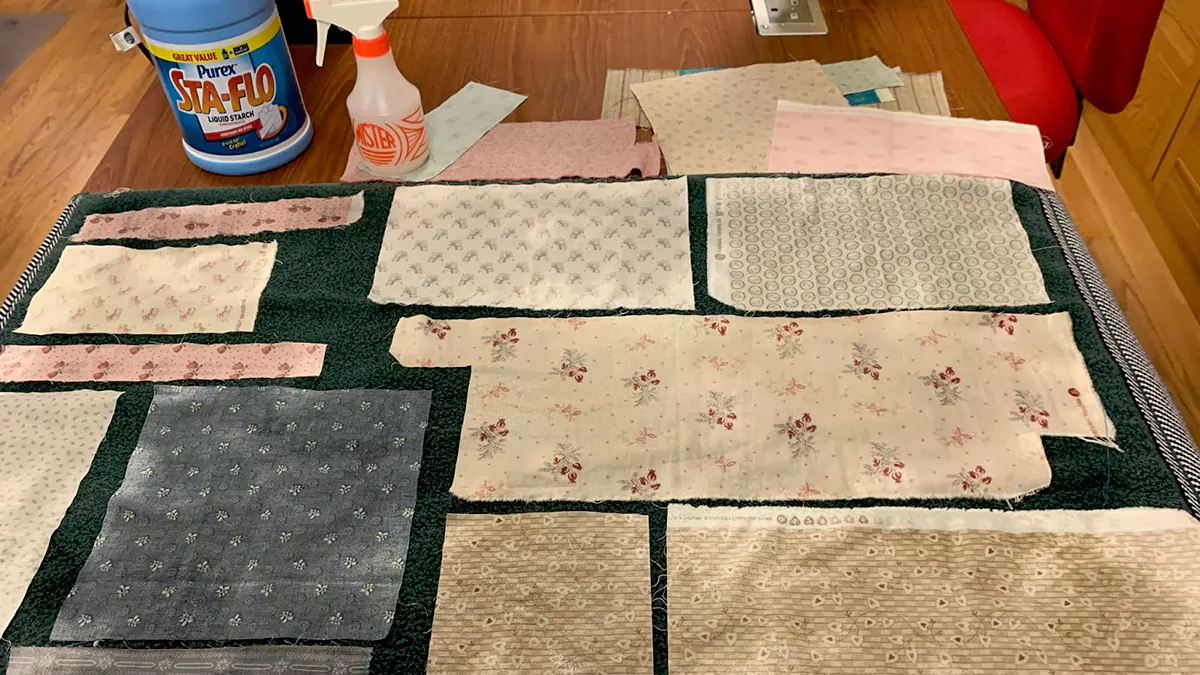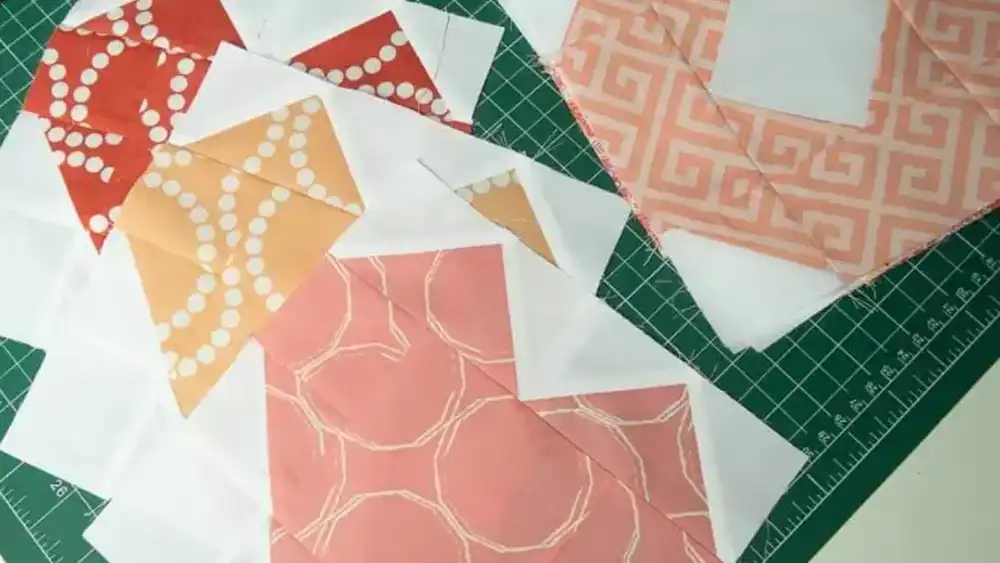Starching fabric is a crucial step in quilting, as it helps stabilize the fabric, making it easier to cut accurately and sew precisely.
This guide will take you through the process of starching fabric for quilting, providing step-by-step instructions, tips, and tricks to achieve the best results.
What Is Fabric Starching?

Fabric starching is a process where fabric is treated with a starch solution to stiffen it. This technique is commonly used in various industries, including quilting, sewing, and garment manufacturing.
Starching fabric serves several purposes, such as enhancing stability, facilitating precise cutting and sewing, minimizing fraying, and improving the overall appearance of the finished product. The starched fabric holds its shape better, making it easier to work with and resulting in neater, crisper results.
Benefits of Starching Fabric for Quilting
Starching fabric for quilting offers several benefits that can enhance the quilting process and the quality of the final quilt. These benefits include:
- Enhanced Stability: Starched fabric is firmer and more stable, reducing stretch and distortion during cutting and piecing.
- Crisp and Sharp Cuts: Starching fabric results in sharper, more precise cuts, allowing for accurate piecing and alignment of quilt blocks.
- Improved Piecing Accuracy: With starched fabric, seams are easier to match and sew accurately, leading to neater and more professional-looking quilt blocks.
- Minimized Fraying: Starched fabric has reduced fraying along the edges, making it easier to handle and work with during the quilting process.
By starching fabric before quilting, quilters can achieve better results and create quilts that are not only visually appealing but also durable and long-lasting.
How to Starch Fabric for Quilting

Step 1: Choose the Right Starch
The first step is selecting the right starch. There are several options available, including spray starch, liquid starch, and homemade starch solutions. Spray starch is the most convenient and widely used option for quilters. It comes in different strengths, such as light, medium, or heavy hold. For most quilting projects, a medium hold starch is ideal as it provides enough stiffness without making the fabric too rigid.
Step 2: Prepare Your Workspace
Before you begin starching, make sure you have a clean, flat surface to work on, such as an ironing board. It’s also a good idea to have a pressing cloth or an old towel on hand to protect your ironing board from starch build-up, which can transfer to other fabrics and cause unwanted stiffness or residue.
Step 3: Apply the Starch
Lay the fabric flat on your ironing board, making sure it’s smooth and free of wrinkles. Hold the spray starch about 6 to 8 inches away from the fabric and apply an even layer. Be careful not to oversaturate the fabric; it should be damp but not soaking wet. If you’re using liquid starch, you may want to dilute it with water and apply it using a spray bottle.
Step 4: Iron the Fabric
Once the starch is applied, it’s time to iron the fabric. Set your iron to the appropriate temperature for your fabric type (usually a cotton setting for quilting fabrics). Start ironing from the center of the fabric and work your way outwards in smooth, even strokes. This will help the fabric absorb the starch evenly and dry without any unwanted creases. Make sure the fabric is completely dry before moving on to the next step.
Step 5: Repeat if Necessary
For fabrics that require extra stiffness, you can repeat the starching and ironing process. Just remember to let the fabric cool down between applications to prevent any scorching or discoloration.
Step 6: Store Your Fabric
After starching, store your fabric properly to maintain its crispness until you’re ready to use it. Fold it neatly and keep it in a dry, cool place. Avoid stacking heavy items on top of it, as this can cause creases that may be difficult to remove later.
Tips for Starching Fabric for Quilting

Test on Scrap Fabric First
Before starching your entire piece of fabric, test the starch solution on a small scrap to determine the desired stiffness and compatibility with your fabric.
Use Distilled Water
For the best results, use distilled water when mixing your starch solution to avoid any mineral buildup or impurities that could affect the fabric.
Avoid Over-Starching
Be cautious not to over-starch your fabric, as excessive starch can make the fabric too stiff and difficult to work with.
Press, Don’t Rub
When ironing the starched fabric, use a pressing motion rather than rubbing the iron back and forth to avoid stretching or distorting the fabric.
When to Starching Fabric for Quilting
Starching fabric for quilting is a step that can significantly impact the quality and precision of your quilting projects. However, knowing when to starch your fabric is just as important as knowing how to do it. The timing of starching can vary depending on the type of project you’re working on and the specific needs of your fabric.
Before Cutting the Fabric
One of the most common times to starch fabric is before cutting it into pieces for your quilt. Starching before cutting helps to stabilize the fabric, making it less likely to shift or stretch during the cutting process. This is particularly beneficial when working with fabrics that tend to fray or stretch easily, such as lightweight cotton or loosely woven materials. Searching at this stage ensures that your fabric holds its shape, leading to more accurate cuts and, ultimately, a more precise quilt.
Before Piecing the Quilting Fabric
Another ideal time to starch your fabric is before you start piecing it together. After cutting, fabrics can lose some of their crispness, especially if they’ve been handled a lot. Applying starch before piecing can help maintain the fabric’s firmness, making it easier to sew straight seams and align the pieces correctly. This step is especially useful when working on intricate quilt designs where precision is crucial.
When Working with Bias Edges
Searching is particularly important when working with bias edges. The bias, or diagonal grain of the fabric, is more prone to stretching and distorting. Starching these edges before sewing can minimize stretching, ensuring that the pieces fit together perfectly. This is essential for maintaining the overall structure and symmetry of your quilt.
Should You Starch Fabric Before Quilting
Starching fabric before quilting is a personal preference for many quilters, and whether or not you should starch fabric depends on various factors and individual preferences.
Here are some considerations to help you decide:
- Fabric Type: Certain types of fabric, such as cotton, benefit more from starching due to their tendency to stretch and fray. However, other fabrics like silk may not require starching.
- Quilting Technique: If you’re working on intricate piecing or appliqué projects that require precise cutting and sewing, starching fabric can be beneficial in achieving crisp, accurate results.
- Ease of Handling: Starched fabric is firmer and easier to handle during cutting and piecing, which can streamline the quilting process and reduce frustration.
- Desired Outcome: Consider the overall look and feel you want to achieve in your quilt. Starched fabric can result in a smoother, more polished appearance, but if you prefer a softer, more drapey quilt, you may opt to skip starching.
- Personal Preference: Ultimately, whether to starch fabric before quilting comes down to personal preference. Some quilters swear by starching for every project, while others prefer to skip it altogether.
FAQs
Can I Use Homemade Starch?
Yes, you can make your own starch solution using cornstarch and water. Simply mix cornstarch with cold water, then add boiling water and heat until thickened.
Will Starching Fabric Wash Out?
Starched fabric will retain its stiffness through washing; however, repeated washings may gradually reduce the stiffness over time.
Can I Starch Different Types of Fabric?
While starching is commonly used on cotton fabric for quilting, it can also be applied to other fabrics such as linen or silk, depending on the desired effect and the fabric’s compatibility with starch.
How Do I Remove Starch from Fabric?
To remove starch buildup from fabric, simply wash the fabric in warm water with mild detergent, then rinse thoroughly and air dry.
Can I Use Starch on Pre-Cut Fabric?
Yes, you can starch pre-cut fabric pieces to enhance their stability and ease of handling during quilting.
Will Starching Fabric Alter the Color?
Starching fabric typically does not alter the color significantly; however, it may enhance the appearance of darker fabrics by adding a subtle sheen.
Conclusion
Starching fabric for quilting is a simple yet effective technique that can elevate the quality of your quilting projects. By following the steps outlined in this guide and incorporating the provided tips and FAQs, you can achieve crisp, precise results that will enhance the beauty and longevity of your quilts.
